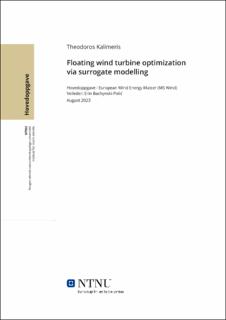| dc.description.abstract | In recent years, the interest in deep-water wind energy projects has drastically increased, driven by the considerable wind resource in deep-water locations. In such locations, floating wind turbines are more economically attractive than bottom-fixed wind turbines. Nevertheless, the floating wind industry faces numerous challenges. One major challenge is the high investment costs involved in the manufacturing of the substructure. Additionally, it is important to maintain the wind turbines’ power output within the required standards for grid connection. Therefore, the design and optimization of substructures for floating wind turbines has to account for both capital costs and power quality. To investigate the existing research on the optimization of floating wind turbines, a literature review was conducted. Evidently, there is limited research investigating both cost and power quality optimization. Furthermore, the majority of the optimization techniques presented are accompanied by a computationally expensive substructure analysis. Moreover, in the early stage of the substructure design, a variety of different alternative scenarios are tested, requiring an extensive number of optimizations. Thus, the computational resources required by the optimization become a major concern. One promising approach to address this issue is substituting a computationally expensive analysis with a surrogate model. This solution could significantly increase the computational efficiency of the optimization process.
This thesis investigates the trade-off between substructure capital cost and power quality optimization. To achieve that, a multi-objective optimization workflow is developed for the case of a semi-submersible substructure. In parallel with this task, the optimization’s analysis blocks requiring most of the computational resources are identified and substituted with a surrogate model. Two different surrogate model implementation approaches have been examined. The first approach substitutes the optimization’s substructure analysis tool (NREL’s RAFT) entirely. This approach is called the ”End-to-End” approach. The second approach substitutes a specific analysis block of RAFT that computes the floater’s hydrodynamic properties. This analysis block requires most of RAFT’s computational resources. This approach is defined as the ”PyHAMS” approach.
The thesis outcome shows that improving the quality of power output comes with the drawback of increasing the substructure’s cost. The Pareto front between these two competing criteria is dominated by designs of long pontoons and reduced chain thickness. This is the most economical approach towards reduced cost and improved power quality. These Pareto designs are mainly driven by the boundaries of the design variables. Additionally, the Pareto designs are affected by constraints on the maximum pitch, maximum surge, and the existence of vertical loads on the mooring line’s anchor. Regarding the surrogate model-based optimizations, there is a dramatic reduction in the computational resources required to conduct the optimization. Among the two surrogate model approaches, the ”PyHAMS” approach achieves a better accuracy at mimicking the original optimization workflow than the ”End-to-End”. Instead, the ”End-to-End” approach is the most computationally efficient one to conduct the optimization. Nevertheless, when factoring in the computational resources to produce the training dataset, the ”PyHAMS” approach is the most computationally efficient one. This is the outcome of utilizing a reduced training dataset compared to one utilized by the ”End-to- End” approach. | |
